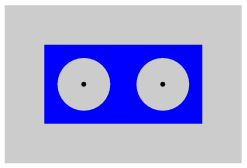دانشنامه ریاضی و کامپیوتر
سایت جامع در باب کتب و جزوات رشته های ریاضی و کامپیوتر با دانلود مستقیم.
سایت جامع در باب کتب و جزوات رشته های ریاضی و کامپیوتر با دانلود مستقیم.
Homology is a concept that is used in many branches of algebra and topology. Historically, the term "homology" was first used in a topological sense by Poincaré. To him, it meant pretty much what is now called a bordism, meaning that a homology was thought of as a relation between manifolds mapped into a manifold. Such manifolds form a homology when they form the boundary of a higher-dimensional manifold inside the manifold in question.
To simplify the definition of homology, Poincaré simplified the spaces he dealt with. He assumed that all the spaces he dealt with had a triangulation (i.e., they were "simplicial complexes"). Then instead of talking about general "objects" in these spaces, he restricted himself to subcomplexes, i.e., objects in the space made up only on the simplices in the triangulation of the space. Eventually, Poincaré's version of homology was dispensed with and replaced by the more general singular homology. Singular homology is the concept mathematicians mean when they say "homology."
In modern usage, however, the word homology is used to mean homology group. For example, if someone says "![]() did
did ![]() by computing the homology of
by computing the homology of ![]() ," they mean "
," they mean "![]() did
did ![]() by computing the homology groups of
by computing the homology groups of ![]() ." But sometimes homology is used more loosely in the context of a "homology in a space," which corresponds to singular homology groups.
." But sometimes homology is used more loosely in the context of a "homology in a space," which corresponds to singular homology groups.
 |
 |
An example of a homology is the degree-one integral homology for a domain in ![]() . In this case, a homology class is represented by a finite sum or difference of closed loops. For example, consider the loops in the twice punctured plane
. In this case, a homology class is represented by a finite sum or difference of closed loops. For example, consider the loops in the twice punctured plane ![]() , illustrated above.
, illustrated above.
The equality ![]() holds in homology because the difference is the homology boundary of a compactly supported region. The homology of a space is an Algebraic object which reflects the topology. The Algebraic tools used are called homological algebra, and in that language, the homology is a derived functor, the homology of a long exact sequence.
holds in homology because the difference is the homology boundary of a compactly supported region. The homology of a space is an Algebraic object which reflects the topology. The Algebraic tools used are called homological algebra, and in that language, the homology is a derived functor, the homology of a long exact sequence.
Singular homology groups of a space measure the extent to which there are finite (compact) boundaryless gadgets in that space, such that these gadgets are not the boundary of other finite (compact) gadgets in that space.
A generalized homology or cohomology theory must satisfy all of the Eilenberg-Steenrod Axioms with the exception of the dimension axiom.
SEE ALSO:Cohomology, Derived Functor, Dimension Axiom, Eilenberg-Steenrod Axioms, Gadget, Geometric Homology, Graded Module, Homological Algebra, Homology Boundary, Homology Class, Homology Group, Homology Intersection, Poincaré Duality, Simplicial Complex, Simplicial Homology, Singular Homology
Portions of this entry contributed by Todd Rowland